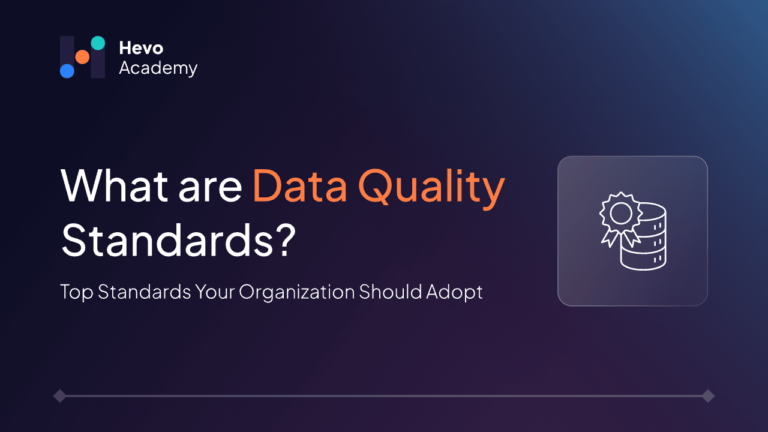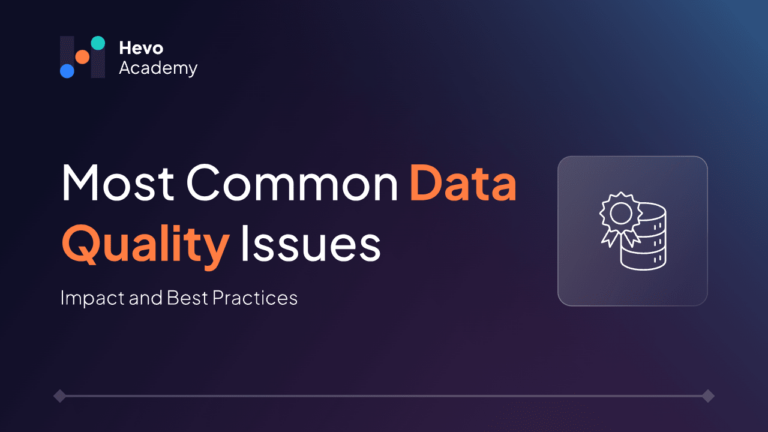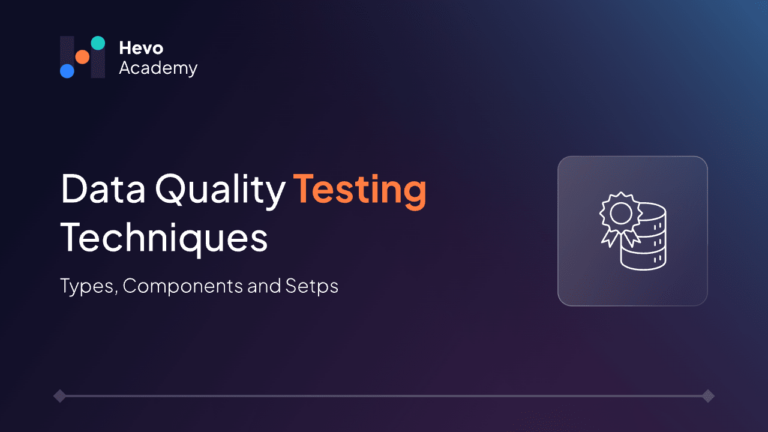Data quality is a measure of the condition of data, based on these 6 data quality dimensions such as accuracy, completeness, uniqueness, consistency, timeliness, validity, and integrity. Every year, due to poor data quality costs organizations an average of $12.9 million, this affects financial loss and reputation damage. As businesses highly rely on data for making informed decisions, poor data quality can lead to misguided data analytics, operational inefficiencies and flawed strategies.
Table of Contents
The goal of having high-quality data is to make data-driven decisions to improve business aspects. For example, a retail company has customer records with incomplete addresses. This results in undelivered packages and increased shipping costs, which in turn affect customer satisfaction due to delays in receiving orders.
What are Data Quality Standards?
Data quality standards are guidelines and criteria used to assess data quality and ensure the accuracy, completeness, consistency, validity, integrity and reliability. Understanding the differences between these dimensions, such as data integrity vs data validity, is essential for implementing data quality standards that support accurate and reliable data usage across systems. Here are the 6 data quality dimensions standards:
1. Accuracy
Data accuracy is one of the 6 dimensions of data quality standards, which refers to how well the data represents real-world entities or the true value it is meant to describe. High data accuracy is important for business as it results in strategic decisions; inaccuracies in data can lead to misguided analytical outcomes and unreliable business strategies.
It helps organizations ensure compliance policies and procedures and also checks whether the data meets all the predefined standards before it is used for data analysis. Data accuracy tools such as Informatica Data Quality and IBM InfoSphere QualityStage improve an organization’s overall operational efficiency without wasting resources. In financial terms, data accuracy prevents misguided analysis reports and maintains investors’ trust.
For example, consider a healthcare organization that maintains patient records. If a patient’s D.O.B. is incorrectly entered, this inaccuracy can lead to several issues, including medical decisions, compliance issues, or insurance claims. Overall, data accuracy plays a vital role in effective data management for analysis.
2. Completeness
Data Completeness ensures that no essential data is missing, critical for accurate data analysis and decision-making. Depending on the business entity, data completeness assesses whether all the required data are present and accounted for in a dataset. Completeness gives a full detailed picture of the subject matter, helping organizations to draw meaningful insights from the data.
An example is a customer’s middle name, which is not essential in deriving marketing strategies, where a customer’s age, demographic area are considered to be highly important to gather insights. This shows even if an attribute in a dataset is missing, the data is still considered complete. Maintaining data completeness requires data audits, reviews and validation processes. Ultimately, every organization strives for complete data for better insights, good communication and good decision-making.
3. Consistency
Data consistency refers to the perfect alignment of all the essential data present in a dataset, even if they are stored in different places, minimizing discrepancies that can ultimately lead to errors. In the data quality dimension, consistency is essential for data integrity maintenance, as it can impact the quality of data analysis reports and decision-making.
Inconsistencies in data such as differing product prices across systems or different spellings of a customer’s name, can create serious operational difficulties and poor customer experience. Especially in healthcare and finance, maintaining data consistency is crucial as it helps in regulatory compliance. In many organizations, data governance frameworks and procedure are implemented to maintain data consistency
4. Uniqueness
Data uniqueness refers to the fact that each record in a dataset should be a distinct value and not duplicated. This attribute is essential to maintaining data integrity and accuracy. It also ensures that each entity, such as a customer’s transaction or a product, is represented only once in the dataset. This data quality dimension prevents data confusion and errors, which can arise from multiple entries.
Uniqueness helps in data management and simplifies duplicate data complexities. To avoid data duplication, organizations often follow unique identifiers, such as product codes and customer IDs. Regular data audits or implementing data validation rules also help in identifying duplicates.
5. Timeliness
Timeliness refers to how up-to-date the data is when needed and its applicability to the current situation or conditions. For example, outdated sales figures could lead to overstocking or stockouts. It is crucial to maintain data, as outdated data can also lead to poor decisions and missed opportunities.
Some key aspects of timeliness in data quality include updating the data frequently, minimizing latency, streamlining the processing speed to enhance timeliness. To consider a data for analysis, it must be relevant to the specific context in which it is used, implying that companies need to know how often to update their data
6. Validity
This data dimension signifies the accuracy and reliability of the data for business requirements. It follows a certain format, to check the integrity and quality of data before it is used for business analysis. There are several ways to check data validation including data type, consistency check, uniqueness, format.
For example, many companies follow a certain age format for their customer database. An age field should be within a range and can only be a numeric value. In a logical range such as 0 to 130, an entry like “-1” would be considered invalid. This logical error can lead to poor data analysis and financial loss.
7. Integrity
Data integrity ensures the accuracy, completeness, consistency and quality of data over its life-cycle. Maintaining data integrity across several formats can be difficult and complex, particularly when dealing with sensitive data like personally identifiable information (PII), including customer name, age, and address. When data is replicated or transferred, it should remain the same without being unaltered between data updates.
Maintaining data integrity is important for several reasons, including data origin and connectivity. Data is likely to be generated from multiple sources, including historical or real-time data. Data integrity is important to improve the quality of business and data-driven decisions.
Inaccurate data leads to poor decisions, financial loss, and wasted effort and time. Several data integrity types are related to database management: entity integrity, referential integrity, domain integrity, and user-defined integrity.
Data integrity can be compromised in various forms, including human errors ( accidental or unintentional), data transfer errors, cybersecurity threats, third-party integration, changes in data structure, software bugs.
Why are Data Quality Standards necessary for your organization?
Data quality standards is essential for a company for several reasons:
- Informed decision-making: High-quality data guarantees that the information is trustworthy and correct, which supports the development of business strategies and customer trust.
- Data Consistency: Data quality standards promote data consistency across various datasets. This dimension of data quality enables better data integration from various departments, leading to better data insights.
- Increased customer trust: When the quality of data is standardized, follows all the regulatory compliance, stakeholders are likely to trust the data
- Enhanced customer experience: Accurate and high-quality data allows for personalized experiences and data insights, leading to customer loyalty.
- Reducing risk intensity: Poor data quality can lead to significant risks, including financial loss or reputation damage. Standardizing data integrity reduces risks.
Guide to Implement Data Quality Standards
Implementing and maintaining data quality standards is essential for ensuring organization’s data. This session provides a step-by-step guide to help you establish data quality standards for reliable and accurate data.
Step 1: Establish Data Quality Objectives
- Setting data quality is important for business requirements, and it is necessary to check whether it meets your data quality initiatives, such as regulatory compliance format or informed decision-making.
- Involve different stakeholders from various departments to learn about their data needs to gather insights and data challenges.
Step 2: Determine Data Quality Dimensions
- Focusing on the relevant seven data quality dimensions—accuracy, completeness, uniqueness, consistency, timeliness, validity, and integrity—helps organizations set clear, measurable goals for high-quality data.
- Define a benchmark for each data quality dimension that aligns with the business needs.
Step 3: Data Quality Assessment
- Organize data audits to examine existing data flow and identify quality issues, such as missing values, data inaccuracies, and duplicate values.
- Employing data profiling and cleansing tools to evaluate data quality metrics to understand the present condition of your data.
Step 4: Create Policies and Procedures for Data Quality
- To promote adherence to data quality standards, create clear guidelines and a framework for data entry, validation, and maintenance.
- Implement standardized data formats to ensure consistency across datasets from different sources.
Step 5: Data Quality Tools
- Profiling, cleansing, data validation, and monitoring are the main considerations in data quality analysis. Appropriate data quality tools to monitor data quality are also important.
- By implementing a data quality tool, it helps in automating data validation and data cleansing processes which reduce manual risks and improve operational efficiency.
- Define KPIs to measure, track data quality process and performance over time.
Step 6: Train staff
- Educate employees on the value of high-quality data and on how to follow certain policies and guidelines.
- Encourage an environment where all staff members share accountability for maintaining data quality.
- Cross-functional teams collaborate on data quality initiatives, bringing best practices.
Step 7: Up-to-date documentation
- Keeping detailed up-to-date documentation of data quality standards helps companies avoid legal penalties.
- Documentation ensures accountability and transparency.
Data quality standards are a continuous process that includes collaboration, evaluation, and commitment. By following these steps, organizations can enhance their data quality, improve efficiency, and gain trust among stakeholders.
Quick Tip: A comprehensive understanding of data reliability vs data validity is fundamental to upholding data quality standards, ensuring that data is both accurate and consistent across use cases
Tools for Data Quality Standards
In today’s data-driven world, implementing robust tools and technologies plays a vital role in enhancing data quality standards for several reasons:
1. Data Cleansing Tool
It is an essential tool for transforming raw, unstructured data into a structured usable data format for business related requirements. Tools like Informatica Data Quality, Talend, Trifacta and Alteryx offer high-quality data and identify issues like duplicates, detecting errors, structuring data and missing values.
2. Data Governance and Compliance Tool
Data governance solutions help manage data policies, compliance, and quality standards across the organization. Tools such as Collibra,Microsoft Purview, Oracle Enterprise Data Governance, and IBM InfoSphere QualityStage facilitate data stewardship by ensuring data is documented and follows industry standards.
3. Data Integration Tool
Data from various data sources are integrated into a single, unified data view, making it easy for users to access and analyze information without navigating multiple systems. It also supports real-time data streaming processes, allowing organizations to react quickly to changes and trends. One of the most popular no-code data integration tools is Hevo Data.
Conclusion
Data quality is crucial for today’s data-driven environment, impacting everything from decision-making to customer satisfaction. Major 6 key dimensions such as accuracy, completeness, uniqueness, consistency, timeliness, validity, and integrity, where data quality determines how effectively businesses can leverage information for strategic advantages.
Data quality becomes a strategic priority as long as firms depend on it for strategic insights. By funding data quality projects, organizations can mitigate risks, boost operational effectiveness, and ultimately produce better business results. In conclusion, obtaining sustainable growth and gaining a competitive edge in today’s fast-paced world require high-quality data.
Sign up for a 14-day free trial and experience the feature-rich Hevo suite first hand. Check out the Hevo pricing details.
Frequently Asked Questions
1. What are the 5 V’s of data quality?
– Volume: Amount of data generated and stored in high volume, potentially impacting data quality if not handled properly.
– Velocity: This defines the speed at which data is generated.
– Variety: Represents structured, unstructured and semi-structured data.
– Veracity: Refers to reliability of data.
– Value: Emphasize importance of data for actionable in-sights.
2. Data integrity vs data quality. What’s the difference?
– Data integrity focuses on data reliability and data structure correctness, whereas data quality evaluates how data serves its intended purpose.
– Data integrity is assessed through rules, while data quality is evaluated using data metrics.
– High data integrity reflects high data quality, but high data quality exists without perfect data integrity.





